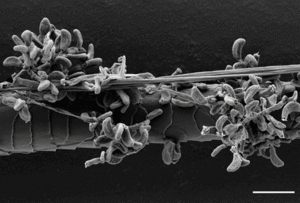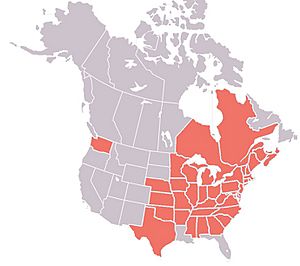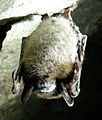White-nose syndrome facts for kids
White-nose syndrome (WNS) is a serious disease that affects bats in North America. It's caused by a type of fungus that grows on the bats' muzzles (noses) and wings, especially when they are hibernating (sleeping for the winter). This fungus looks like a white fuzzy growth, which is how the disease got its name.
WNS was first noticed in a photo taken in a cave in New York in 2006. Since then, it has spread very quickly. By 2018, it was found in 33 U.S. states and seven Canadian provinces. The fungus itself has also been found in other states, even if the bats there haven't shown the disease yet. Most of the affected areas are in the eastern parts of the U.S. and Canada, but it has also reached states like Washington and California.
The disease is caused by a fungus called Pseudogymnoascus destructans. This fungus grows on the bats' skin. There isn't a known cure or easy way to stop it from spreading. Some bat species have seen their populations drop by more than 90% in just five years after the disease arrived in their area.
Because WNS is so dangerous, the United States Fish and Wildlife Service (USFWS) has asked people to avoid caving in affected areas. They also strongly recommend cleaning any clothing or equipment used in caves after each visit to prevent spreading the fungus.
Contents
Why White-Nose Syndrome Matters
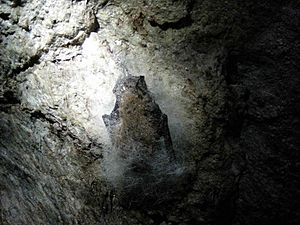
White-nose syndrome has caused a huge number of bat deaths in North America. By 2012, it was estimated that between 5.7 million and 6.7 million bats had died. In some caves, bat populations dropped by over 90% in just one year. Experts have called it the biggest threat bats have ever faced.
Many different bat species have been affected by WNS. This includes species that were already in danger, like the Indiana bat and the little brown bat. The northern long-eared myotis has almost completely disappeared from places where the disease has been present for more than four years.
Bats are very important for our environment. They eat millions of insects, which helps farmers protect their crops from pests. It's estimated that bats save U.S. farmers about 3 billion dollars each year by controlling insects. Bats also help pollinate plants and spread seeds, which is vital for healthy ecosystems. When bat populations decline, it can have a big impact on these natural services.
Bat Species Affected by WNS
Here are some of the North American bat species that have been confirmed to have white-nose syndrome:
| Confirmed North American bat species identified with diagnostic symptoms of white-nose syndrome: | ||||
|---|---|---|---|---|
| Image | Scientific name | Common Name | Range | Conservation Status |
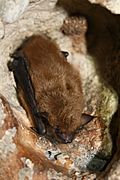 |
Eptesicus fuscus | Big brown bat |  |
Least Concern |
 |
Myotis evotis | Long-eared myotis |  |
Least Concern |
 |
Myotis grisescens | Gray bat | 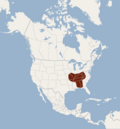 |
Vulnerable |
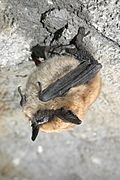 |
Myotis leibii | Eastern small-footed bat |  |
Endangered |
 |
Myotis lucifugus | Little brown bat | 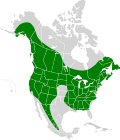 |
Endangered |
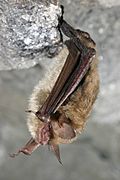 |
Myotis septentrionalis | Northern myotis | 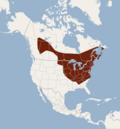 |
Near threatened |
 |
Myotis sodalis | Indiana bat |  |
Near threatened |
 |
Myotis thysanodes | Fringed myotis | 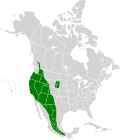 |
Least Concern |
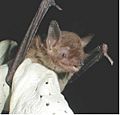 |
Myotis velifer | Cave myotis |  |
Least Concern |
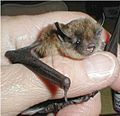 |
Myotis volans | Long-legged myotis |  |
Least Concern |
 |
Myotis yumanensis | Yuma bat |  |
Least Concern |
 |
Perimyotis subflavus | Tricolored bat | 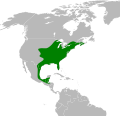 |
Vulnerable |
Understanding the Disease
Scientists are working hard to learn more about WNS. Biologists from the US Fish and Wildlife Service collect information from affected caves. They track how many bats are sick, how far the disease has spread, and take samples from affected bats. They also work with groups like the Northeastern Cave Conservancy to track the movements of people who visit caves.
In 2009, the Service suggested closing caves to visitors in 20 states to try and stop the spread. This was later extended to more states. Experts worried that if the disease reached caves further south, millions more bats could die.
What Causes WNS?
The main cause of WNS is the fungus Pseudogymnoascus destructans. This fungus grows best in cold temperatures, between 4–15°C (39–59°F). It cannot grow in temperatures above 20°C (68°F).
Studies have shown that if healthy bats are infected with this fungus, they will develop the disease. The fungus grows on the bats' skin, especially on their wings. The fungus has been found on bats in Europe and Asia for a long time, but it doesn't seem to cause unusual deaths there. Scientists believe the fungus was likely brought to North America by humans, perhaps by accident, as bats don't normally travel between Europe and North America.
How WNS Spreads
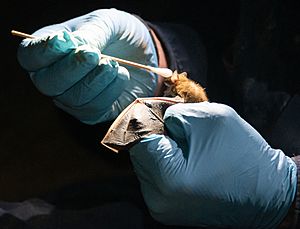
Experiments suggest that bats need to touch each other to spread the fungus. Bats in cages next to infected bats did not get the fungus, meaning it's probably not airborne. The main ways the fungus spreads are through bat-to-bat contact or from an infected cave surface to a bat.
The role of humans in spreading the disease is still being discussed. It's possible that the fungus was brought to North America by human activities, especially since it was first found in New York, a major travel hub. Research shows that the fungus can survive on human clothing, meaning people could accidentally carry it from one cave to another.
Signs of the Disease
The most obvious sign of WNS is the white fuzzy growth on the bats' muzzles and wings. However, the fungus can also be present in smaller amounts without being easily seen.
Scientists believe that WNS causes bats to wake up too often during hibernation. When bats hibernate, they lower their body temperature and slow down their metabolism to save energy. Each time they wake up, they use a lot of energy. If they wake up too often, they can use up all their fat reserves and starve to death before spring. Some sick bats even leave their winter shelters in search of food, risking death from the cold.
How WNS Harms Bats
The fungus grows on the bats' wings, which are very important for their bodies. This causes bats to use more energy than they should during hibernation. It also affects their blood, making it more acidic and causing problems with chemicals like potassium.
The damage to their wings might make bats wake up more often from their deep sleep. Waking up helps them fix their blood chemistry, but it also makes them lose water and use up their stored fat. This creates a cycle where the bats get sicker, wake up more often, and lose more energy and water, eventually leading to death.
Where WNS Has Spread
WNS was first reported in New York caves in 2007. By 2008, it had spread to Vermont, Massachusetts, and Connecticut. In the following years, it continued to spread across the eastern U.S. and into Canadian provinces like Ontario and Quebec.
By 2014, the disease had been confirmed in 25 states and 5 Canadian provinces. The fungus itself was also found in three more states: Iowa, Minnesota, and Mississippi.
In March 2016, a little brown bat with WNS was found in Washington state, which was the first time it was seen so far west. The fungus has continued to spread, reaching Kansas and Manitoba in 2018. In 2019, the fungus was even found in Bracken Cave in Texas, home to the world's largest bat colony. In 2021, the first bat death from WNS was confirmed in Montana. By early 2023, the fungus was detected in British Columbia, Canada.
Stopping the Spread
The fungus that causes WNS can be found in soil inside infected caves. This means it can be carried from cave to cave on human clothing and equipment. To prevent spreading the fungus, people are encouraged to clean their gear very carefully. There are special cleaning rules for cavers to follow. In some cases, it's even recommended to use new gear instead of reusing disinfected items.
Sometimes, caves are completely closed to visitors to protect the bats. Disturbing hibernating bats, even with a quiet visit, can cause them to wake up, use up their energy, and die. If you ever see hibernating bats, it's important to leave them alone immediately.
Possible Treatments
Scientists are looking for ways to treat bats with WNS. A study in 2019 found that bats treated with a special helpful bacteria, called Pseudomonas fluorescens, were five times more likely to survive after hibernation. This is a promising step in finding ways to help bats fight this disease.
See also
 In Spanish: Síndrome de la nariz blanca para niños
In Spanish: Síndrome de la nariz blanca para niños
- Anthropocene
- Chytridiomycosis
- Decline in amphibian populations
- Holocene extinction
Images for kids
-
A little brown bat with white-nose syndrome.


